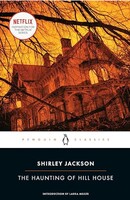Book notes: The Haunting of Hill House
Jan 26, 2025
By Shirley Jackson.
I searched the Internet for “best horror book of all time”, and this book came up on the top two hits: a Forbes article, and a subreddit on favorite horror novels.
Scoring:
- Axe for the frozen sea: 10/10.
- Page count: 182, effective page count: a bit less than that.
A professor wants to study a local “haunted” house (Hill House) to see if it is truly haunted. He recruits 3 other strangers to spend some time in the house with him and take notes. One of the strangers is Elanor, 32 year old single woman, and the story is told from her point of view. Her story until that point had been one of loneliness… she had spent the past decade taking care of her sick mom. (Spoilers) The four people spend several days exploring the oddities of the house and there are some terrifying moments… Theodora has all of her clothes mysteriously shredded, Elanor’s name is written on the wall, there are clawing/knocking noises outside their bedrooms at night. But they don’t outright leave? Why not? Is Elanor going crazy and imagining these things? I think the house was trying to keep her, and it did it’s best to isolate her, make her paranoid, and make her feel welcome and included, like a toxic boyfriend. In the last chapters Elanor relents and commits to the house and the house lets her see and hear what it sees, Elanor becomes giddy with the power, and runs wild. Journeys end in lovers meeting. ;-) The professor seems to figure out what is happening, and tries to make Elanor leave the house so she can recover. Elanor feels like she belongs to the house and can’t leave, so she commits suicide by driving her car into a tree.
The conversational dynamics in this group of 30-somethings (and one older professor) was fun most of the time, but often teetered into overly-sarcastic and borderline mean like middle school. I remember thinking “why can’t these people communicate normally”? But after finishing the book and giving it some thought, there might be a few reasons: 1) The book is intentionally exploring loneliness and paranoia. The story is told from Elanor’s point of view, and she frantically processes each sentence in conversations: Why would Theodora say that? Does she think less of me?, so the conversation might not be literally what was said, just what Elanor interpreted. 2) The house is likely affecting the conversations to isolate Elanor. 3) Any group that agrees to hang out in a haunted house with strangers could be socially flawed. :-)
The professor’s wife “Mrs. Montague” (a fantastically-entertaining character for the book!) visited for a couple of days and used her planchette - a device used to channel writing like a ouija board - and got a message: “Elanor, home”. I had to laugh because this fortuneteller-reveals-actual-truth scene happened in the North Woods book as the one I just finished a few weeks ago. (And same recap: Is the house haunted? Yes.)
This was more of a psychological thriller than a horror like I was expecting, but it was still very good and creepy! I have to admit this book had me searching the Internet for other interpretations of what happened.